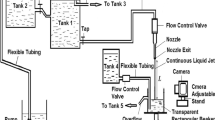Abstract
Break up of water jets under gravity is a ubiquitous phenomenon. The role of surface tension on the instability of uniform water jets was recognised long ago by Plateau and Rayleigh. According to the Plateau–Rayleigh theory, external (or internal) perturbation waves create necks and bulges all along the uniform jet length. The perturbation waves of wavelengths larger than a certain value keep growing with time and ultimately cause the continuous jet to break up into individual drops. The effect of external perturbation waves was investigated experimentally, in most cases under gravity, and found to confirm the essentials of the theory. Recently, the idea of recoil capillary waves as a possible internal source of perturbations was emphasised. According to this idea, immediately after the break up of the jet, the tip of the remaining continuous jet (after a drop is detached) recoils. Its effect travels upstream as a recoil capillary wave which gets reflected at the mouth of the jet-issuing nozzle. The reflected capillary wave travels downstream along the jet with its Doppler-shifted wavelength as a reinforcing perturbation wave and, as a result, affecting the break up length of the jet. We set up and perform an experiment to verify the existence of these tip contraction recoil capillary waves. The results of our experiment support the existence of these recoil capillary waves. However, the effect of these capillary waves on the jet break up length is found to be small.








Similar content being viewed by others
References
J Eggers, Rev. Mod. Phys. 69, 865 (1997)
J Eggers and E Villermaux, Rep. Prog. Phys. 71, 036601 (2008)
S P Lin, Breakup of liquid sheets and jets (Cambridge University Press, 2010)
A Javadi, J Eggers, D Bonn, M Habibi and N M Ribe, Phys. Rev. Lett. 110, 144501 (2013)
S Le Dizes and E Villermaux, J. Fluid Mech. 810, 281 (2017)
J W S Rayleigh, Proc. London Math. Soc. 10, 4 (1879)
J W S Rayleigh, The theory of sound (Dover Publications, New York, 1945) Vol. II, pp. 351–375
S Chandrasekhar, Hydrodynamic and hydromagnetic stability (Dover Publications, New York, 1961)
R J Donnelly and W Glaberson, Proc. Roy. Soc. A 290, 547 (1966)
E F Goedde and M C Yuen, J. Fluid Mech. 40, 495 (1970)
D F Rutland and G J Jameson, J. Fluid Mech. 46, 267 (1971)
A Umemura, Phys. Rev. E 83, 046307 (2011)
A Umemura, S Kawanabe, S Suzuki and J Osaka, Phys. Rev. E 84, 036309 (2011)
W K Bani and M C Mahato, AIP Conf. Proc. 1832, 060008 (2017)
We have used a (3.5–4.99 mW) Taurus Series 635 nm (Class IIIa) red laser pointer, a photoconductive LDR \((1~{\rm k}\Omega )\) sensor (detector), a UA741CN Op Amp, a SN74LS14N Hex Inverter Schmidt Trigger, a 74ALS04BN Hex Inverter, HCF4033BEs and CD4026BEs decade counters, a NE555P timer, HEF4082BPs AND Gate, Common Cathode 7-Segment single digit LED display in the experimental set-up
K Dreyer and F R Hickey, Am. J. Phys. 59, 619 (1991)
M Hancock and J W M Bush, J. Fluid Mech. 466, 285 (2002)
The flow rate is measured manually by collecting the jet water on a measuring cylinder for two minutes and calculating the mean value
Acknowledgements
The authors thank Mr M C Deka of Guwahati, India, for fabricating the glassware used in our experimental set-up.
Author information
Authors and Affiliations
Corresponding author
Rights and permissions
About this article
Cite this article
Bani, W.K., Mahato, M.C. An experimental study of recoil capillary waves and break up of vertically flowing down water jets. Pramana - J Phys 95, 21 (2021). https://doi.org/10.1007/s12043-020-02064-y
Received:
Revised:
Accepted:
Published:
DOI: https://doi.org/10.1007/s12043-020-02064-y




